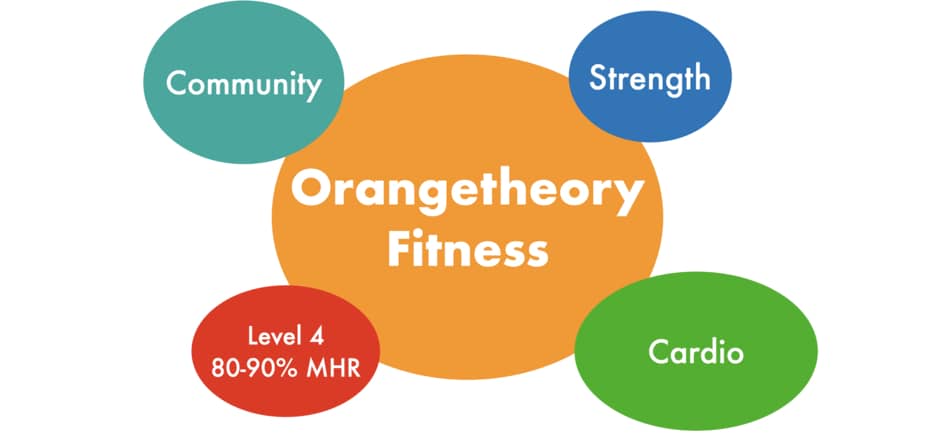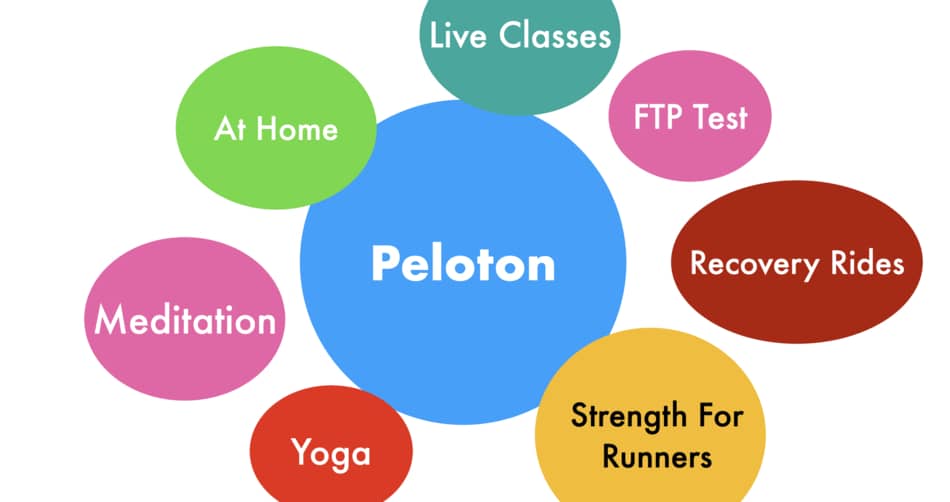The idea behind Orangetheory fitness is to exercise with intensity at 84-91% of maximum heart rate, which they call the level 4 “orange” heart rate. The level 4 heart rate zone promises to burn more calories and stimulate EPOC after the workout.
I will briefly explain how effective is this theory, but the goal of this article is to compare OTF with a Peloton and help you decide which one is better.

As a whole, the peloton is better than Orangetheory because you get the same training effects from using the bike or tread at home that from OTF. Also, the peloton uses the power output based on individual FTP scores as their measurement for effort level, which is more precise than a heart rate monitor.
What is Orangetheory Fitness?
Overall, Orangetheory fitness is a boutique fitness studio franchise with over one million members.
OTF became popular because of their unique workouts that alternate cardio together with strength training in one session.
How does Orangetheory work? In general, the Orangetheory works like a group circuit training where you rotate between three stations – rowing, running, and strength training. Every member needs to wear a heart rate monitor that is connected to the large screen and displays their current heart rate.
What does Orangetheory do for your body?
As a whole, working out with the Orangetheory keeps your intensity high enough to stimulate positive training adaptations like increased lactate threshold and better muscle glycogen storage. This translates into a higher metabolic rate, better performance, and stamina.

What is Peloton?
Unless you’ve been living under the rock, you probably heard about the rapidly growing company that specializes in selling home spin bikes and treadmills.
How does the peloton work? Overall, the peloton’s main focus is to train at home using their bike or treadmill by either joining one of the several live-steam classes or choosing one of the 24,000 on-demand sessions. It uses a fitness app that has several classes like cycling, strength, yoga, running, and meditation.
What does a Peloton do for your body?
In general, the peloton workouts are mainly focused on the bike however the company is expanding its fitness class selection in many workout genres. You can improve your health, build muscle, reduce body fat, as well as improve your performance.

What Are Different Types of Orangetheory Classes?
The Orangetheory has one type of class that is divided into two, based on its duration and the cardio-to-strength training ratio.
They call it 2G and 3G.
The difference between 3G and 2G is that 2G sporadically uses the rower, whereas 3G has its dedicated rower section.
Here is the OTF class breakdown:
- Running
- Rowing
- 3-4 strength training exercises
The goal of the class is to complete as many rounds as possible within 45 or 60 minutes. What I love about the OTF is the vibe because it’s competitive, but in a nice way. This means you compete against yourself, which helps to stay motivated.
Orangetheory doesn’t have spin or yoga classes
As a whole, the Orangetheory isn’t like a regular gym or a fitness center with a fitness timetable for a spin, yoga, or pilates classes.
For example, every workout in their facility is about the same exercises (treadmill, rower, strength), which means you will do the same workout each time you book a class.
Learn more: Click here to learn what’s the difference between “9round vs orange theory“.
Peloton Digital vs Orangetheory Online
Another thing you need to know about is that OTF launched they on-demand fitness class library that is free of charge. All you need is to download the app and choose from several workouts.
Does Orangetheory have online classes? Overall, Orangetheory does have online classes on their fitness app, as well as on their youtube channel. The classes are very basic and use mainly bodyweight exercises. Each class is organized into rounds and blocks with 4 exercises per block.
There is a big difference between the OTF app and the peloton app because the peloton has over 24,000 classes across 13 workout genres.
The peloton classes can be filtered by class type, difficulty level, music, and even instructor.
The Orangetheory has only a handful of classes but they are free to use.

Does Peloton Have Classes like OrangeTheory?
There are many classes in the peloton app that are exactly like Orangetheory. One that has a similar training method is called Bootcamp, where you also use cardio and strength together.
Another way to get a similar OTF effect in the peloton is by training at the tempo power zone.
Tempo power zone is one of the power-based training levels that measure your current effort level.
The built-in power meter in the bike uses the mathematical algorithm that calculated your effort from cadence and resistance. This way you get immediate feedback about your workout intensity (more on that next).
Peloton Bootcamp vs Orangetheory
Overall, the peloton Bootcamp is very similar to Orangetheory because it uses the same principle of alternating cardio with resistance training for the number of rounds.
The only difference is that peloton Bootcamp doesn’t require using the heart rate monitor.
Both Peloton Bootcamp and Orangetheory Fitness are effective
In general, the peloton Bootcamps are effective because they combine full-body workouts with running or cycling while having a minimum recovery time. This allows for elevated heart rate and greater EPOC (excess post-exercise oxygen consumption).
I won’t be covering here all the details regarding peloton Bootcamp classes. I’ve already covered that in my “peloton Bootcamp” article, which I recommend you read.
Peloton Power Zones vs Orangetheory Zones
What I like about peloton and Orangetheory is they both use scientific evidence in their fitness program. In both programs, you have a way to measure your intensity and adjust your exercise based on that numbers. This helps to optimize every workout.
NOTE: You can learn more about “orange theory heart rate zones” in my article here.
Below you can see how the peloton power zone compares to the Orangetheory zones.
| Peloton Zone | MaxHR | Orangetheory Zone |
|---|---|---|
| Recovery | <68% | Zone 1 |
| Endurance | 69-83% | Zone 3 |
| Tempo | 84-94% | Zone 4 (orange zone) |
| LA | 95-105% | Zone 5 |
| VO2max | >106% | Zone 5 |
HOWEVER.
There is a big difference between peloton power zones and Orangetheory zones because the Orangetheory uses a heart rate monitor, whereas the peloton is using a power output. The power output is more accurate because of several variabilities that can affect your current heart rate.
This means you can have a much higher (or lower) heart rate, not because of your training intensity, but because of something not related to the workout.
For example.
- Heat
- Dehydration
- Caffeine
- Medications
- Recent illness or infection
- Lack of sleep
- Diet
- Stress
That is one of the reasons why calories calculated by the heart rate have such a huge discrepancy.
On the other hand, power output is more reliable because it’s calculated based on your cadence and resistance.
After you’ve taken the peloton FTP test, you will unlock the power bar and have immediate feedback on your intensity.
Of course, this doesn’t mean that heart rate monitors are faulty. They are still a viable way to measure intensity. If you have had an Orangetheory heart rate monitor you can connect that to your peloton and join the classes.
Peloton vs Orangetheory Calories Burned
Overall, the Orangetheory calorie estimate isn’t accurate because it’s based on the heart rate equation.
Calculating calorie expenditure based on the heart rate doesn’t take into consideration any factors influencing heart rates like weather, temperature, or emotions.
Yes, emotions do affect your heart rate
Studies have shown that emotions have an impact on heart rate and heart rate variability. This can lead to inaccurate data if you’re using a heart rate monitor as a calorie expenditure measurement tool.
Exercise can be emotional, especially if you’re in a competitive class with encouraging fitness trainers and motivating music.
This means your number can be off by even 10-20% from the actual energy expenditure.
So if you’ve ever been wondering why you burn so many calories at Orangetheory is because of the inaccurate reading via the heart rate monitor.
The most accurate way to know your calorie expenditure is via direct or indirect calorimetry, usually done in a laboratory setting.
Peloton vs Orangetheory For Beginners
One thing that I don’t like about the Orangetheory is the lack of a beginner program. Sure you can do fewer reps than everyone else or use different, less strenuous exercises.
However, in general, this class is excellent for people who are already motivated and consistent.
For example, I wouldn’t recommend this class to my mother.
Does Orangetheory have beginner classes? As a whole, the Orangetheory doesn’t have beginner classes. The workouts are all 45 to 60 minutes long and require you to train at almost the peak of your heart rate. This is optimal for intermediate and advanced people, but not beginner-friendly.
Please remember that it’s very difficult to maintain the correct exercise technique if your heart rate is racing and you have minimum time to rest in between the rounds.
Plus, the class is always packed with groups of people hopping from one station to another so the trainers can’t keep an eye on everyone.
Ideally, an instructor on the site should be there to help everyone. But I find that the trainers are there more to “motivate” rather than spend quality time one-on-one with every individual who seems to struggle with correct form.
Lastly, it may feel intimidating when everyone is knowing what they’re doing and keeps up with the pace, apart from you.
Peloton has thousands of beginner classes
On the other hand, the peloton is more realistic when it comes to beginners. They do a series of strength, cycling, and yoga tutorials where they spend most of the time teaching you the foundation.
This way you not only gradually increase the muscle stamina, but also learn how to perform the exercise the correct way.
Learn more: Click here to learn more about “best peloton strength classes for beginners“.
Peloton vs Orangetheory For Weight Loss
There is not much difference between Peloton and Orangetheory when it comes to weight loss because both workouts are proven to be effective in improving metabolic rate and burning calories.
However, the peloton offers recovery sessions that help to down-regulate after a hard workout.
Recovery classes help with weight loss
As a whole, recovery is important for weight loss because it allows for to reduce of muscle soreness, speeds up muscle perfusion and reduces stress.
The high intensity is effective, but too much of it can lead to overtraining, fatigue, and lower performance.
In other words, the body needs adequate rest to stimulate optimal training adaptations and reap the benefits from the exercise. If all you do is HIIT and high volume then sooner or later this can lead to under-recovery and burnout.
Here are some of the ideas you can do using the Peloton app to enhance your recovery.
- Recovery rides
- Low-impact rides
- Restorative yoga
- Outdoor walking
To get the full list of “best peloton recovery classes” and learn why they are important, check out my article.
Orangetheory doesn’t have recovery classes
Overall, the Orangetheory doesn’t have recovery classes because all of its workouts involve high-intensity interval training.
The only component of recovery is 5 minutes of cool down after the class.
That being said, the OTF does work for weight loss because training at the sub-maximal heart rate not only burns more calories but also helps to reduce appetite. Several studies have shown that exercise facilitates weight loss, partly through effects on appetite regulation.
In other words, you get less hungry when you exercise (Dorling et al. 2018).
Plus, exercise also reduces stress, which is another huge factor that drives people to eat food, even when they are not hungry.
For weight loss, Peloton is the winner
Overall, the peloton is better than Orangetheory for weight loss not only because it has more class variety, but also because it allows you to stay active without leaving your home.
Learn more: You can learn more about how to maximize weight loss with Orangetheory in my article. Details here.
What About User Experience?
The orange theory and peloton are completely different but are based on the same idea; provide an excellent experience. They both have advantages and disadvantages, however, they both meet the exact needs of their customers.
Convenience
The peloton is more convenient than Orangetheory because it can be done at home, without being dependent on the schedule. It also doesn’t require commuting to the facility.
You have 24/7 access to the bike (or tread) and you can join the live classes stream in 2 different locations that fit all time zones.
Price
Initially, the Orangetheory seems more affordable because it doesn’t require a large upfront cost. However, in the long term, the peloton is a better deal because it has lower monthly costs.
Is Peloton worth the extra money? Overall, the peloton is worth extra money because over the long haul you end up paying less for access to world-class fitness products, compared to OTF or other brands.
Take a look below at the comparison table where I break down the cost of peloton and OTF initial vs 48 months from now.
| Peloton | Orangetheory | |
|---|---|---|
| Initial | $1495 | – |
| Monthly | $44 | $150-$200 |
| 12 months total | $2,023 | $1,800-$2,400 |
| 24 months total | $2,551 | $3,600-$4,800 |
| 36 months total | $3,079 | $5,400-$7,200 |
| 48 months total | $3,607 | $7,200-$9,600 |
As you can see, if you plan to train with Orangetheory for 4 years, it will set you back $7,200 to $9,600, depending on where you live. That’s over a $5,000 difference.
With peloton you pay only a big amount upfront, and after is only $44/month.
NOTE: If you’re looking for an affordable alternative, you can read more about the list of “gyms like an orange theory but cheaper” in my article here.
Social Community
I think that Orangetheory has more to offer when it comes to social support because you experience in-person social interaction. Meeting people in person carries more value and can transform into real-life relationships.
On the other hand, with the peloton, you have a thriving online community that is extremely welcoming for everyone. They are always eager to help, motivate, and inspire, especially the new joiners.
If you want to use fitness classes as a way to meet new people, the Orangetheory is your best option.
What Else is Similar to Orangetheory?
One of the most popular fitness franchises that are similar to Orangetheory is F45 training and CrossFit. They have a different exercise routine but are as challenging as OTF.
Learn more: You can learn more about “why I quit F45” in my article here.
F45 training is a group fitness class where you mix cardio with strength. Within a week you will have either a cardio-focused class, a strength-focused class, or a combination of both.
CrossFit is also a group fitness workout that includes several Olympic lifts and gymnastic exercises. I have a few clients who love doing Crossfit and were asking me if peloton is good for CrossFit. You can read here my recommendations.
Conclusion
In general, the peloton is more diverse and holistic than Orangetheory because apart from high-intensity sessions it also offers many low-impact and recovery rides, yoga, and stretching classes, as well as beginner-friendly tutorial programs.
Also, in the long haul, it is less expensive, especially if more than one person is using the bike. However, if you value social interaction and meeting people in person, the OTF is a better choice.
